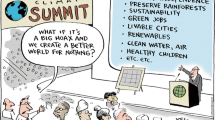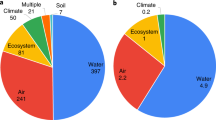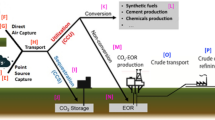Abstract
The Montreal Protocol is often described as an international environmental agreement par excellence. After all, it successfully led to the phase-out of almost 95% of all chlorofluorocarbon (CFC) use. A critical review of the Protocol’s history, however, suggests that its successes are deeply entrenched in the economic opportunities that were made available to phase out CFCs. The Montreal Protocol, in other words, was a “best-case scenario” for CFC producers. This may be problematic for policymakers, ecological modernization practitioners, and other scholars who look to the Montreal Protocol for guidance in phasing out other global environmentally harmful substances and practices that are not as “economically efficient.” The shift to delay the phasing out of methyl bromide (MeBr) in the Protocol, an ozone-depleting substance used to this day primarily in strawberry and tomato production, demonstrates how even this most successful of international environmental agreements can become subject to significant setbacks when economic gains and scientific evidence are not obvious to the global powers. Furthermore, changes in what constitutes a viable exemption to the phase-out of CFCs versus MeBr marks a shift away from concern for the general functioning/welfare of society, and toward concern for the market performance of specific individuals. This shift runs parallel to a lack in economic incentives to phase out MeBr in the United States. The article demonstrates how civil society representation in ozone politics is largely dominated by industry interests, especially when scientific uncertainty is high.
Similar content being viewed by others
Notes
It must be noted that recent works in ecological modernization, such as Mol et al. (2009) indeed illustrate the influence that the nation-state maintains in international environmental agreements.
Parson makes the interesting observation that this was the first time that a chemical’s inertness, and not its reactivity, was a serious environmental threat. That CFCs could remain non-reactive until they reached the stratosphere was the very attribute that threatened life worldwide (Parson 2003, p. 32).
By 1984, the U.S. reversed its position again: “The United States, previously the most forceful advocate of binding and compulsory arbitration, had reversed its position after being sued in the World Court for mining Nicaragua’s harbors and losing its procedural bid to avoid the court’s jurisdiction” (Parson 2003, p. 121).
Synthesis Report, UNEP/OZL.Pro.WG.II(1)/4 (89-1-11) p. 9.
Interview with the author at the 16th MOP, Prague, 22 November 2004.
QPS uses are currently exempt from phase-out under the Montreal Protocol.
Final Report of the 7th Meeting of the Parties to the Montreal Protocol on Substances that Deplete the Ozone Layer. Both environmental groups and—later and anonymously—members of MBTOC criticized the 1995–1998 average given to developing countries, worried that it would increase consumption of MeBr over that period in order to get the base level at a higher level. It is likely true that this happened, and, as Parson relates, it likely benefited the chemical companies greatly, who were responsible for up to 85 percent of ODS usage in places like Thailand (2003, p. 231, fn. 187).
Final Report of the Ninth Meeting of the Parties to the Montreal Protocol on Substances that Deplete the Ozone Layer.
On July 6, 2005, the E.U. published a notice of initiation of a safeguard investigation concerning imports of frozen strawberries from the Chinese mainland. The issue was raised by Poland, which complained that China imports could endanger its domestic production (USDA Foreign Agricultural Service 2005: 4).
For a more complete account of the global competition in strawberries, please see Gareau (2008b).
Claudia McMurray, U.S. Delegation, 15th Meeting of the Parties to the Montreal Protocol, 14 November 2003, Nairobi, tape-recorded notes.
Abbreviations
- CFCs:
-
Chlorofluorocarbons
- CUE:
-
Critical use exemption
- EPA:
-
United States Environmental Protection Agency
- HCFCs:
-
Hydrochlorofluorocarbons
- MBTOC:
-
Methyl bromide Technical Options Committee
- MeBr:
-
Methyl bromide
- MOP:
-
Meeting of the parties to the Montreal Protocol
- NASA:
-
U.S. National Aeronautics and Space Administration
- NGO:
-
Non-governmental organization
- ODS:
-
Ozone-depleting substance
- ODP:
-
Ozone-depleting potential
- TEAP:
-
Technology and Economics Assessment Panel
- UNEP:
-
United Nations Environmental Programme
References
Andersen, S. O., Morehouse, E. T., Jr., & Miller, A. (1994). The military’s role in protection of the ozone layer. Environmental Science and Technology, 28(13), 586A–589A.
Andersen, S. O., Sarma, K. M., & Sinclair, L. (2002). Protecting the ozone layer: The United Nations history. London: Earthscan Publications.
Bailey, I., & Wilson, G. A. (2009). Theorising transitional pathways in response to climate change: Technocentrism, ecocentrism and the carbon economy. Environment and Planning A, 41(10), 2324–2341.
Bankobeza, G. M. (2005). Ozone protection: The international legal regime. The Netherlands: Eleven Publishing.
Banks, J. (1998). Methyl bromide technical options committee. In P. G. LePretre, J. D. Reid, & E. T. Morehouse Jr. (Eds.), Protecting the ozone layer: Lessons, models and prospects (pp. 167–172). Boston: Kluwer.
Barrett, S. (2003). Environment & statecraft: The strategy of environmental treaty-making. Oxford: Oxford University Press.
Beck, U. (1992). Risk society: Towards a new modernity. Newbury Park, CA: Sage
Benedick, R. E. (1998). Ozone diplomacy: New directions in safeguarding the planet (Enl. ed.). Cambridge, MA: Harvard University Press.
Bernstein, S. (2002). The compromise of liberal environmentalism. New York: Columbia University Press.
Borrego, J. (2000). The restructuring of frozen food production in North America and its impacts on daily life in two communities: Watsonville, California and Irapuato, Guanajuato. In N. Klahn, A. Alvarez, F. Manchon, & P. Castillo (Eds.), New frontiers of the 21st century (pp. 491–543). Mexico City: DEMOS.
Breitmeier, H., & Rittberger, V. (2000). Environmental NGOs in an emerging global civil society. In P. S. Chasek (Ed.), The global environment in the twenty-first century: Prospects for international cooperation (pp. 130–163). New York: United Nations University Press.
Butler, J. H., Elkins, J. W., Hall, B. D., Cummings, S. O., & Montzka, S. A. (1992). A Decrease in the growth rates of atmospheric halon concentrations. Nature, 359(6394), 403–405.
California Strawberry Commission. (2006). California frozen exports 2006. Retrieved February 08, 2008, from www.calstrawberry.com.
California Strawberry Commission. (2008). California delivers on Olympic athlete’s request for strawberries. Retrieved May 15, 2009, from http://www.calstrawberry.com/commission/inthenews.asp.
Canan, P., & Reichman, N. (2002). Ozone connections: Expert networks in global environmental governance. Sheffield: Greenleaf.
Carter, C. A., Chalfant, J. A., & Goodhue, R. E. (2005a). China’s strawberry industry: An emerging competitor for California? ARE Update, 9(1), 7–15.
Carter, C. A., Chalfant, J. A., Goodhue, R. E., Han, F. M., & DeSantis, M. (2005b). The methyl bromide ban: Economic impacts on the California strawberry industry. Review of Agricultural Economics, 27(2), 181–197.
Centre for Civil Society. (2004, March). What is civil society. Retrieved May 12, 2009, from The London School of Economics, Political Science Center for Civil Society website: http://www.lse.ac.uk/collections/CCS/what_is_civil_society.htm.
Chemical Week. (1988, April 16). Chemical Week, 142 (14), 7.
Conca, K. (2006). Governing water: Contentious transnational politics and global institution building. Cambridge: MIT Press.
DeCanio, S. J. (2003). Economic analysis, environmental policy, and intergenerational justice in the Reagan administration: The case of the Montreal Protocol. International Environmental Agreements: Politics, Law and Economics, 3, 299–321.
DeCanio, S., & Norman, C. S. (2005). Economics of the ‘‘critical use’’ of methyl bromide under the Montreal Protocol. Contemporary Economic Policy, 23(3), 376–393.
Dryzek, J. S., Downes, D., Hunold, C., Scholsberg, D., & Hernes, H.-K. (2009). Ecological modernization, risk society, and the green state. In A. P. J. Mol, D. A. Sonnenfeld & G. Spaargaren (Eds.), The ecological modernization reader: Environmental reform in theory and practice (pp. 226–253). New York: Routledge.
DuPuis, E. M., & Gareau, B. J. (2008). Neoliberal knowledge: The decline of technocracy and the weakening of the Montreal Protocol. Social Science Quarterly, 89(5), 1212–1229.
Environment News Service. (2005). Developing countries funded for ozone safe technology. Retrieved October 13, 2006 from http://www.ens-newswire.com/ens/dec2005/2005-12-16-01.asp.
Environment News Service. (2006). South Pole ozone recovery 20 years later than expected. Retrieved October 12, 2006, from http://www.ens-newswire.com/ens/jun2006/2006-06-30-05.asp.
FAO. (2005). Fresh strawberry production statistics. UN Food and Agriculture Organization. Retrieved October 10, 2006, from http://www.fao.org.
Farman, J. C., Gardiner, H., & Shanklin, J. D. (1985). Large losses of total ozone in antarctica reveal seasonal ClOx/NOx interaction. Nature, 315, 207–210.
Fisher, D., Fritsch, O., & Anersen, M. S. (2009). Transformations in environmental governance and participation. In A. P. J. Mol, D. A. Sonnenfeld, & G. Spaargaren (Eds.), The ecological modernisation reader: Environmental reform in theory and practice (pp. 141–155). New York: Routledge.
Flannery, T. F. (2005). The weather makers: How man is changing the climate and what it means for life on Earth. New York: Atlantic Monthly Press.
Gareau, B. J. (2008a). Dangerous holes in global environmental governance: The roles of neoliberal discourse, science, and California agriculture in the Montreal Protocol. Dissertation, University of California.
Gareau, B. J. (2008b). Dangerous holes in global environmental governance: The roles of neo-liberal discourse, science, and california agriculture in the Montreal Protocol. Antipode, 40(1), 102–130.
Gareau, B. J., & Crow, B. (2006). Ken Conca governing water: Contentious transnational politics and global institution building. International Environmental Agreements: Politics, Law and Economics, 6(3), 317–320.
Gareau, B. J., & DuPuis, E. M. (2009). From public to private global environmental governance: Lessons from the Montreal Protocol’s stalled methyl bromide phase-out. Environment & Planning A, 41(10), 2305–2323.
Goldman, M. (2005). Imperial nature: The World Bank and struggles for social justice in the age of globalization. New Haven: Yale University Press.
Goodhue, R. E., Fennimore, S. A., & Ajwa, H. A. (2005). The economic importance of methyl bromide: Does the California strawberry industry qualify for a critical use exemption from the methyl bromide ban? Review of Agricultural Economics, 27(2), 198–211.
Haas, P. M. (1992). Banning chlorofluorocarbons. International Organization, 46(1), 187–224.
Hajer, M. (1995). The politics of environmental discourse: Ecological modernisation and the policy process. Oxford: Oxford University Press.
Huber, J. (2009). Upstreaming environmental action. In A. P. J. Mol, D. A. Sonnenfeld, & G. Spaargaren (Eds.), The ecological modernisation reader: Environmental reform in theory and practice (pp. 334–355). New York: Routledge.
Hunter, D., Salzman, J. & Zaelke, D. (2002). International environmental law and policy (University Casebook Series). New York: Foundation Press.
Hunter, D., Salzman, J. & Zaelke, D. (2007). International environmental law and policy (3rd Ed., University Casebook Series). New York: Foundation Press.
Jänicke, M., & Jörgens, H. (2009). New approaches to environmental governance. In A. P. J. Mol, D. A. Sonnenfeld, & G. Spaargaren (Eds.), The ecological modernisation reader: Environmental reform in theory and practice (pp. 156–189). New York: Routledge.
Lipschutz, R., & Mayer, J. (1996). Global civil society and global environmental governance. Albany, NY: SUNY Press.
Litfin, K. (1994). Ozone discourses: Science and politics in global environmental cooperation. New York: Columbia University Press.
Mol, A. P. J. (1996). Ecological modernization and industrial reflexivity: Environmental reform in the late modern age. Environmental Politics, 5, 302–323.
Mol, A. P. J. (2000). The environmental movement in an era of ecological modernization. Geoforum, 31, 45–56.
Mol, A. P. J., Sonnenfeld, D., & Spaargaren, G. (Eds.). (2009). The ecological modernisation reader: Environmental reform in theory and practice. New York: Routledge.
Mol, A. P. J., & Spaargaren, G. (2000). Ecological modernization theory in debate: A review. Environmental Politics, 9, 17–49.
Mol, A. P. J., & Spaargaren, G. (2002). Ecological modernization and the environmental state. In A. P. J. Mol & F. H. Buttel (Eds.), The environmental state under pressure (pp. 33–55). Oxford: Elsevier.
Murphy, J., & Gouldson, A. (2000). Environmental policy and industrial innovation: Integrating Environment and economy through ecological modernisation. Geoforum, 31, 33–44.
Norman, C. S. (2005). Potential impacts of imposing methyl bromide phaseout on US strawberry growers: A case study of a nomination for a critical use exemption under the Montreal Protocol. Journal of Environmental Management, 75(2), 167–176.
Norman, C. S., DeCanio, S. J., & Fan, L. (2008). The Montreal Protocol at 20: Ongoing opportunities for integration with climate protection. Global Environmental Change, 18(2), 330–340.
Oberthur, S. (2001). Linkages between the Montreal and Kyoto Protocols: Enhancing synergies between protecting the ozone layer and the global climate. International Environmental Agreements: Politics, Law and Economics, 1, 357–377.
Parson, E. A. (1993). Protecting the ozone layer. In P. M. Haas, R. O. Keohane, & M. A. Levy (Eds.), Institutions for the earth: Sources of effective international protection (pp. 27–74). Cambridge, MA: MIT Press.
Parson, E. A. (2003). Protecting the ozone layer: Science and strategy. Oxford: Oxford University Press.
Rittberger, V. (2000). (I)NGOs and Global Environmental Governance: Introduction. In P. S. Chasek (Ed.), The global environment in the twenty-first century: Prospects for international cooperation (pp. 83–86). New York: United Nations University Press.
Rowland, F. S., & Molina, M. J. (1994). Ozone depletion: 20 Years after the alarm. Chemical and Engineering News, 72(August 15), 8–13.
Science. (1991). Ozone loss hits us where we live. Science, 254, 645.
Sonnenfeld, D. A., & Mol, A. P. J. (2002). Ecological modernization, governance, and globalization: Epilogue. American Behavioral Scientist, 45(9), 1456–1461.
UNEP. (1991). Environmental effects panel report. Report of the Environmental Effects Panel of the Montreal Protocol. Nairobi: United Nations Environmental Programme.
UNEP. (1994). Scientific assessment of ozone depletion: 1994. In WMO/UNEP (Ed.), Report of the scientific assessment panel of the Montreal Protocol. WMO Global Research and Monitoring Project. Geneva: United Nations Environmental Programme.
UNEP. (1995). Report of the methyl bromide technical options committee, 1995 assessment. Nairobi: United Nations Environmental Programme.
UNEP. (2002). Protecting the ozone layer: The United Nations history. Nairobi: United Nations Environmental Programme.
UNEP. (2007a). Brief primer on the Montreal Protocol. United Nations Environmental Programme. Retrieved on August 20, 2007, from http://ozone.unep.org/Publications/MP_Brief_Primer_on_MP-E.pdf.
UNEP. (2007b). Report of the 19th meeting of the parties to the Montreal Protocol on substances that deplete the ozone layer. Nairobi: United Nations Environmental Programme.
UNEP. (2009). Progress report of the UNEP technology and economic assessment panel. Nairobi: United Nations Environmental Programme. Retrieved from http://www.unep.org/ozone/teap/Reports/TEAP_Reports/.
U.S. Committee on Agriculture. (2000). The implications of banning methyl bromide for fruit and vegetable production. U.S. House of Representatives Committee on Agriculture. Second Session, July 13.
USDA Foreign Agricultural Service. (2005). GAIN report: China frozen exports. United States Department of Agriculture Foreign Agricultural Service.
van der Leun, J. C. (2004). The ozone layer. Photodermatology, Photoimmunology and Photomedicine, 20, 159–162.
Wapner, P. (1996). Environmental activism and world civic politics. Albany: State University of New York Press.
Wapner, P. (2000). The transnational politics of environmental NGOs: Governmental, economic, and social activism. In P. S. Chasek (Ed.), The global environment in the twenty-first century: Prospects for international cooperation (pp. 87–108). New York: United Nations University Press.
Whitney, C. R. (1989). 20 Nations agree to join ozone pact. New York Times, March 8.
Yearly, S. (1995). The environmental challenge to science studies. In S. Jasanoff, G. E. Markle, J. C. Petersen & T. Pinch (Eds.), Handbook of science and technology studies (pp. 457–479). Thousand Oaks, CA: Sage.
Young, O. (1994). International governance: Protecting the environment in a stateless society. Ithaca: Cornell University Press.
Acknowledgments
Thanks are due to Wally Goldfrank, Ronnie Lipschutz, E. Melanie DuPuis, Ben Crow, John Borrego, Harro van Asselt, and two anonymous referees for their exceptional advice on the preparation of this manuscript. Funding for this research was provided by the University of California STEPS Institute for Innovation in Environmental Research, the University of California Center for Agroecology and Sustainable Food Systems, the University of California Pacific Rim Research Program, and the Department of Sociology at the University of California, Santa Cruz.
Author information
Authors and Affiliations
Corresponding author
Rights and permissions
About this article
Cite this article
Gareau, B.J. A critical review of the successful CFC phase-out versus the delayed methyl bromide phase-out in the Montreal Protocol. Int Environ Agreements 10, 209–231 (2010). https://doi.org/10.1007/s10784-010-9120-z
Accepted:
Published:
Issue Date:
DOI: https://doi.org/10.1007/s10784-010-9120-z




